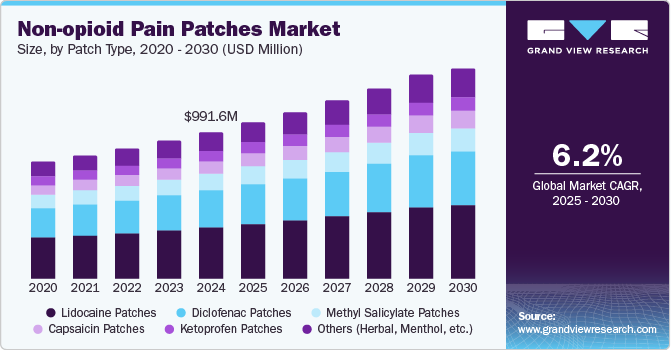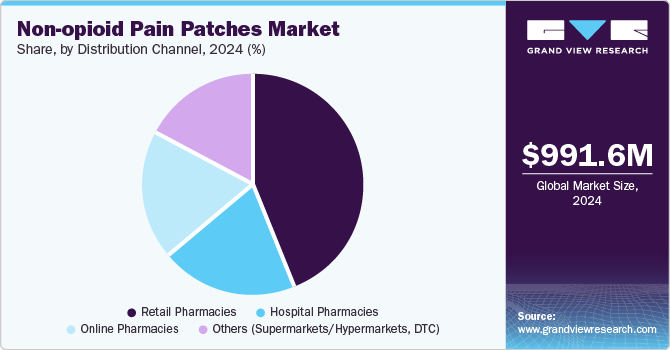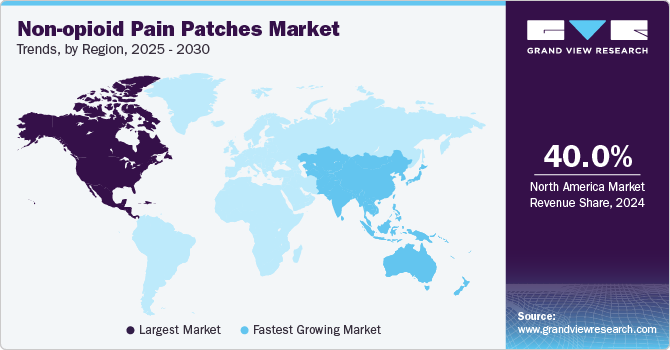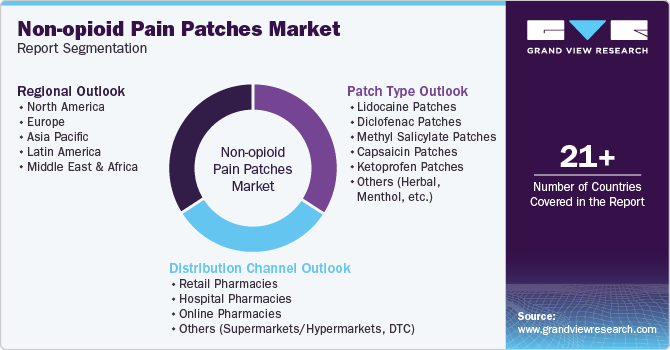- Home
- »
- Pharmaceuticals
- »
-
Non-opioid Pain Patches Market Size & Share Report, 2030GVR Report cover
![Non-opioid Pain Patches Market Size, Share & Trends Report]()
Non-opioid Pain Patches Market Size, Share & Trends Analysis Report By Patch Type (Lidocaine, Diclofenac, Methyl Salicylate, Capsaicin, Ketoprofen), By Distribution Channel, By Region, And Segment Forecasts, 2025 - 2030
- Report ID: GVR-4-68038-003-3
- Number of Report Pages: 100
- Format: PDF, Horizon Databook
- Historical Range: 2018 - 2023
- Forecast Period: 2025 - 2030
- Industry: Healthcare
Non-opioid Pain Patches Market Trends
The global non-opioid pain patches market size was estimated at USD 991.6 million in 2024 and is projected to grow at a CAGR of 6.2% from 2025 to 2030. The alarming increase in opioid prescriptions and related overdose deaths has prompted healthcare providers and patients to seek effective non-opioid solutions. Non-opioid pain patches offer localized relief without the addictive potential associated with opioids, making them highly preferred among stakeholders in the healthcare system. As the call for safer alternatives becomes more pronounced, the market for these patches is positioned for robust expansion.

The growing prevalence of chronic pain is another critical driver for the non-opioid pain patches market. Approximately 50 million Americans suffer from chronic pain, highlighting the urgent need for effective pain management options. Non-opioid pain patches address various types of pain, including chronic, neuropathic, and musculoskeletal pain, thereby tackling a significant healthcare challenge. According to the European Pain Federation, in Europe, an estimated 100 million individuals experience chronic pain, representing approximately 20% of the adult population. This condition is a major contributor to disability, accounting for over 50% of sickness absences, which adversely impacts social and work life across multiple European countries.
In Amsterdam, recent surveys indicate that around 30% of adults report experiencing chronic pain, reflecting the broader trends observed in urban areas across Europe, where women are more frequently affected than men. As chronic pain issues continue to escalate, there is an increasing demand for effective management solutions, propelling the adoption of non-opioid pain patches. Moreover, technological advancements are poised to further accelerate market growth. Continuous research and development in transdermal delivery systems have led to the creation of more effective non-opioid pain patches.
Innovations in drug formulation and patch design have significantly enhanced both efficacy and user experience. In tandem with this, increased awareness among patients and healthcare providers regarding the benefits of non-opioid therapies fosters greater acceptance and utilization. Educational initiatives and guidelines promoting non-opioid treatments are facilitating a shift away from traditional opioid prescriptions, thus creating an environment conducive to the market’s expansion. The rise of online pharmacies and retail outlets has made non-opioid pain patches more accessible to consumers, ensuring easier purchasing options and a more robust market presence.
Patch Type Insights
Licodaine patches held the largest market share of 35.0% in 2024, owing to their established efficacy in alleviating various pain types, including neuropathic and musculoskeletal pain. Offering localized relief with minimal systemic side effects, these patches are a preferred choice for patients and healthcare providers, further supported by their availability in both over-the-counter and prescription formulations.
Capsaicin patches are expected to grow rapidly, witnessing a CAGR of 6.7% over the forecast period. Capsaicin patches effectively manage pain from conditions such as osteoarthritis, neuropathy, and muscle injuries by depleting substance P, a neurotransmitter involved in pain signaling. With rising concerns over opioid risks, these non-invasive patches provide targeted relief with minimal side effects, enhancing patient compliance and driving their growing popularity in pain management.
Distribution Channel Insights
Retail pharmacies dominated the market with a revenue share of 44.6% in 2024. A variety of non-opioid pain patches are available over-the-counter, enabling customers to purchase them without prescriptions. Retail pharmacies offer an extensive range of pain management products, catering to chronic pain sufferers and responding to heightened demand for safer alternatives amid the ongoing opioid crisis, thereby enhancing sales.

Online pharmacies are projected to grow at the fastest CAGR of 8.1% over the forecast period. The digitization of healthcare enables patients to conveniently order non-opioid pain patches online, ensuring prompt delivery without the need for in-store visits. This benefits individuals with mobility challenges and offers a broader product selection and competitive pricing, promoting safer alternatives amid rising concerns about opioid addiction.
Regional Insights
North America non-opioid pain patches market dominated the global market with a revenue share of 40.0% in 2024. North America is increasingly aware of the opioid crisis, highlighting the necessity for safer pain management alternatives. The prevalence of chronic pain conditions drives demand, while advancements in transdermal delivery technologies enhance efficacy, positioning non-opioid patches as a favored choice, supported by clinical guidelines advocating for their adoption.

U.S. Non-opioid Pain Patches Market Trends
The non-opioid pain patches market in U.S. dominated the North America non-opioid pain patches market with a revenue share of 88.6% in 2024. The alarming rise in opioid-related overdose statistics in the U.S. has driven healthcare providers to explore safer pain relief alternatives. Innovations such as lidocaine and diclofenac patches provide effective localized pain management, while increased accessibility through retail and online pharmacies supports consumer adoption amidst governmental initiatives to reduce opioid prescriptions.
Europe Non-opioid Pain Patches Market Trends
Europe non-opioid pain patches market held substantial market share in 2024. The rising awareness of opioid-related risks has spurred demand for non-opioid alternatives. Regulatory backing for innovative pain management, along with a focus on patient-centered care, fuels market expansion. Advancements in patch technology enhance efficacy for neuropathic and musculoskeletal pain, appealing to healthcare providers and patients.
The non-opioid pain patches market in Germany is expected to grow in the forecast period, driven by a strong healthcare system and a rising prevalence of chronic pain. The focus on innovative medical technologies fosters the adoption of advanced non-opioid patches, as healthcare professionals increasingly seek safer alternatives to opioid prescriptions.
Asia Pacific Non-opioid Pain Patches Market Trends
Asia Pacific non-opioid pain patches market is expected to register the fastest CAGR of 7.0% in the forecast period. Increasing urbanization and lifestyle changes are contributing to a rise in chronic pain conditions. Escalating healthcare expenditures and enhanced access to medical services are prompting patients to seek effective pain management solutions. The growth of e-commerce platforms facilitates access to non-opioid alternatives, driving research and development.
The non-opioid pain patches market in China is projected to grow at the fastest rate of 8.0% in the Asia Pacific market over the forecast period. The Chinese government’s initiatives to combat opioid abuse are driving a transition to safer pain management alternatives. Furthermore, advancements in pharmaceutical research have resulted in innovative non-opioid patch formulations that improve efficacy and patient compliance, while increased consumer acceptance of transdermal delivery systems fosters market growth.
Key Non-opioid Pain Patches Company Insights
Some key companies operating in the market include Acorda Therapeutics, Inc.; Teva Pharmaceutical Industries Ltd.; GSK plc; among others. The market comprises established pharmaceutical firms and emerging innovators in drug delivery systems, engaging in mergers, partnerships, and online distribution to enhance product efficacy and patient compliance.
-
Teva Pharmaceutical Industries Ltd. is a global company working in generic and specialty pharmaceuticals, producing transdermal patches that deliver medications such as lidocaine and diclofenac for localized pain relief, emphasizing innovation and accessibility in non-opioid pain management solutions for chronic conditions.
-
Endo, Inc. is focused on branded and generic pharmaceuticals, including non-opioid pain patches, utilizing transdermal delivery systems to manage neuropathic and musculoskeletal pain while prioritizing research and development to expand its safer, effective pain relief portfolio amidst rising opioid addiction concerns.
Key Non-opioid Pain Patches Companies:
The following are the leading companies in the non-opioid pain patches market. These companies collectively hold the largest market share and dictate industry trends.
- Acorda Therapeutics, Inc.
- Teva Pharmaceutical Industries Ltd.
- GSK plc
- Endo, Inc.
- Hisamitsu Pharmaceutical Co.,Inc.
- IBSA Institut Biochimique SA
- Alkermes
- Teikoku Pharma
- Mylan N.V.
Recent Developments
-
In October 2024, Hisamitsu Pharmaceutical announced the initiation of clinical development for HP-3150, a transdermal diclofenac sodium patch for chronic lower back pain treatment in the U.S., using its advanced drug delivery technology.
-
In May 2024, Teikoku Pharma USA announced that the NMPA approved Lidoderm for treating Post Herpetic Neuralgia in China, following an exclusive licensing agreement with Link Healthcare Group since 2018.
Non-opioid Pain Patches Market Report Scope
Report Attribute
Details
Market size value in 2025
USD 1.1 billion
Revenue forecast in 2030
USD 1.4 billion
Growth rate
CAGR of 6.2% from 2025 to 2030
Base year for estimation
2024
Historical data
2018 - 2023
Forecast period
2025 - 2030
Quantitative units
Revenue in USD million/billion and CAGR from 2025 to 2030
Report coverage
Revenue forecast, company ranking, competitive landscape, growth factors, trends
Segments covered
Patch Type, distribution channel, region
Regional scope
North America; Europe; Asia Pacific; Latin America; Middle East & Africa
Country scope
U.S., Canada, Mexico, UK, Germany, France, Italy, Spain, Denmark, Sweden, Norway, China, Japan, India, Australia, South Korea, Thailand, Brazil, Argentina, South Africa, Saudi Arabia, UAE, Kuwait
Key companies profiled
Acorda Therapeutics, Inc.; Teva Pharmaceutical Industries Ltd.; GSK plc; Endo, Inc.; Hisamitsu Pharmaceutical Co.,Inc.; IBSA Institut Biochimique SA; Alkermes; Teikoku Pharma; Mylan N.V.
Customization scope
Free report customization (equivalent up to 8 analysts working days) with purchase. Addition or alteration to country, regional & segment scope.
Pricing and purchase options
Avail customized purchase options to meet your exact research needs. Explore purchase options
Global Non-opioid Pain Patches Market Report Segmentation
This report forecasts revenue growth at global, regional, and country levels and provides an analysis of the latest industry trends in each of the sub-segments from 2018 to 2030. For this study, Grand View Research has segmented the global non-opioid pain patches market report based on patch type, distribution channel, and region:

-
Patch Type Outlook (Revenue, USD Million, 2018 - 2030)
-
Lidocaine Patches
-
Diclofenac Patches
-
Methyl Salicylate Patches
-
Capsaicin Patches
-
Ketoprofen Patches
-
Others (Herbal, Menthol, etc.)
-
-
Distribution Channel Outlook (Revenue, USD Million, 2018 - 2030)
-
Retail Pharmacies
-
Hospital Pharmacies
-
Online Pharmacies
-
Others (Supermarkets/Hypermarkets, DTC)
-
-
Regional Outlook (Revenue, USD Million, 2018 - 2030)
-
North America
-
U.S.
-
Canada
-
Mexico
-
-
Europe
-
UK
-
Germany
-
France
-
Italy
-
Spain
-
Denmark
-
Sweden
-
Norway
-
-
Asia Pacific
-
Japan
-
China
-
India
-
Australia
-
South Korea
-
Thailand
-
-
Latin America
-
Brazil
-
Argentina
-
-
Middle East & Africa
-
South Africa
-
Saudi Arabia
-
UAE
-
Kuwait
-
-
Share this report with your colleague or friend.
![gvr icn]()
NEED A CUSTOM REPORT?
We can customize every report - free of charge - including purchasing stand-alone sections or country-level reports, as well as offer affordable discounts for start-ups & universities. Contact us now
![Certified Icon]()
We are GDPR and CCPA compliant! Your transaction & personal information is safe and secure. For more details, please read our privacy policy.
We are committed towards customer satisfaction, and quality service.
"The quality of research they have done for us has been excellent."





